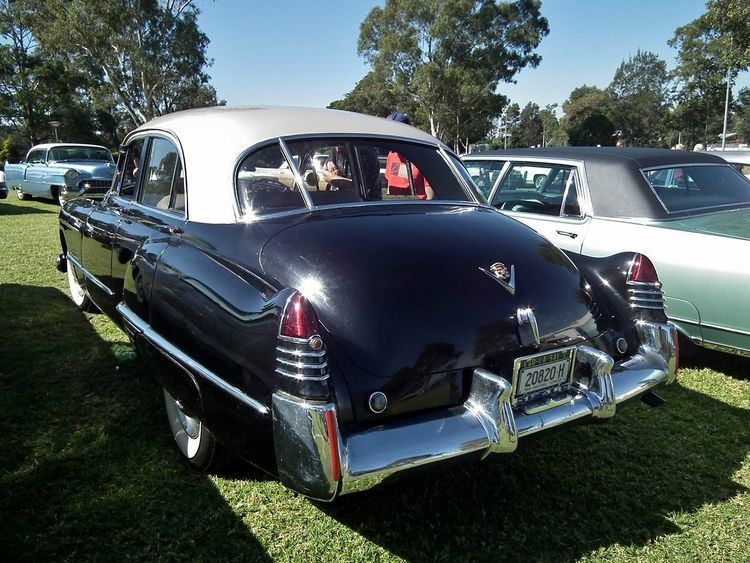 | ||
The tailfin era of automobile styling encompassed the 1950s and 1960s, peaking between 1957 and 1961. It was a style that spread worldwide, as car designers picked up styling trends from the US automobile industry, where it was regarded as the "golden age" of American auto design.
Contents
General Motors design chief Harley Earl is generally credited for the automobile tailfin, introducing small fins on the 1948 Cadillac. Harley credited the look of World War II fighter aircraft for his inspiration, particularly the twin-tailed P-38 Lightning. Tailfins really captured the automotive buying public’s imagination as a result of Chrysler designer Virgil Exner’s Forward Look, which subsequently resulted in manufacturers scrambling to install larger and larger tailfins onto new models. As jet-powered aircraft, rockets, and space flight entered into public recognition, the automotive tailfin assemblies (including tail lights) were designed to resemble more and more the tailfin and engine sections of contemporary jet fighters and space rockets.
Plymouth claimed that the tailfins were not fins, but "stabilizers" to place the "center of pressure" as far to the rear as possible and thus "reduce by 20% the needs for steering correction in a cross wind", while Mercedes-Benz called its own tailfins “Peilstege” or “sight lines,” which ostensibly aided in backing up.
Background
Automobile engineer Paul Jaray added a center fin to his prototype designs in the 1920s for aerodynamic stability. Influenced by his patents some car producers made streamlined prototypes with one center positioned tailfin. For example, the Audi F5 Stromliner prototype, Kdf-Wagen prototype, Tatra T77 production car or Fiat Padovan prototype.
Some sub-models of the 1937 Cadillac Fleetwood, which predates the P-38, also contained hints of tailfins via projecting tail-light "paddles", although it is unclear if this influenced later fin designs. The 1941 Cadillac Series 63 4-Door Sedan also had a form of jutting tail-lights, although milder than the 1937 Fleetwood. Even though the 1948 model was the first conscious effort at fins, the earlier partial occurrences may have made the concept more acceptable to consumers and designers. (World War II produced a gap of Cadillac model production between the early 1940s and late 1940s as factories turned to military goods production, interrupting the development of the fin concept.)
Tailfin era
The Cadillac 1948 fin styling proved popular, and its use spread to other models in the General Motors family of brands. Soon it was adopted by other manufacturers, with top Chrysler stylist Virgil Exner in particular taking the tailfin look on board. As confidence grew in the styling trend, the fins grew larger and bolder.
The most extreme tailfins appeared in the late 1950s, such as on the 1959 Cadillac Eldorado and the 1959 Chevrolet Impala. Soaring, sharply pointed, and bearing twin round taillights, they engendered a backlash against the look. Tailfins descended throughout the early 1960s, even adopting a downward slope on the 1965 Cadillacs. Mostly they disappeared, although in instances a sharp-edged quarter panel meeting a downward sloping trunk created the look if not illusion of fins. Vestigial tailfins, however, remained on American cars into the 1990s, at least as far as the 1999 Cadillac Deville.
Mercedes-Benz introduced a modest tailfin on its 1959 W111 series of sedans, which gained the nickname "Fintails". In company terminology they were Peilstege (sight lines) for aid in backing up. In 1997, Lancia introduced the Lancia Kappa Coupé with similar rear "sight line" augmentation.
Legacy
Tailfins have been criticized as a safety concern, even as a parked vehicle. In Kahn v. Chrysler (1963), a seven-year-old child on a bicycle collided with a fin and sustained a head injury. A case of the same era, Hatch v. Ford (1958), is also prominent in the study of personal injury from parked vehicles. In both of these cases, children were injured by sharp protrusions on parked cars.
Examples of tailfin styling:
Comeback
In 1999 Cadillac launched the Cadillac Evoq concept to lead the new design known as the art and science campaign. Recent Cadillacs have taken onboard this design and have the signature vertical taillamp tailfins. Cadillac's designers call the current Cadillacs's styling evocative of tailfins. In 2010, the Cadillac SRX styling incorporated the trademark vertical taillights sculpted into tiny tailfins projecting from the rear. This was also done with the Cadillac XTS, which launched in 2012, and with many other models in later years.
Though not officially mentioned by the manufacturer, reviews from the media compared the sharp angles of the fourth generation Toyota Prius tail-lights similar to tailfins. This can be clearly seen when the tail-lights are lit.
